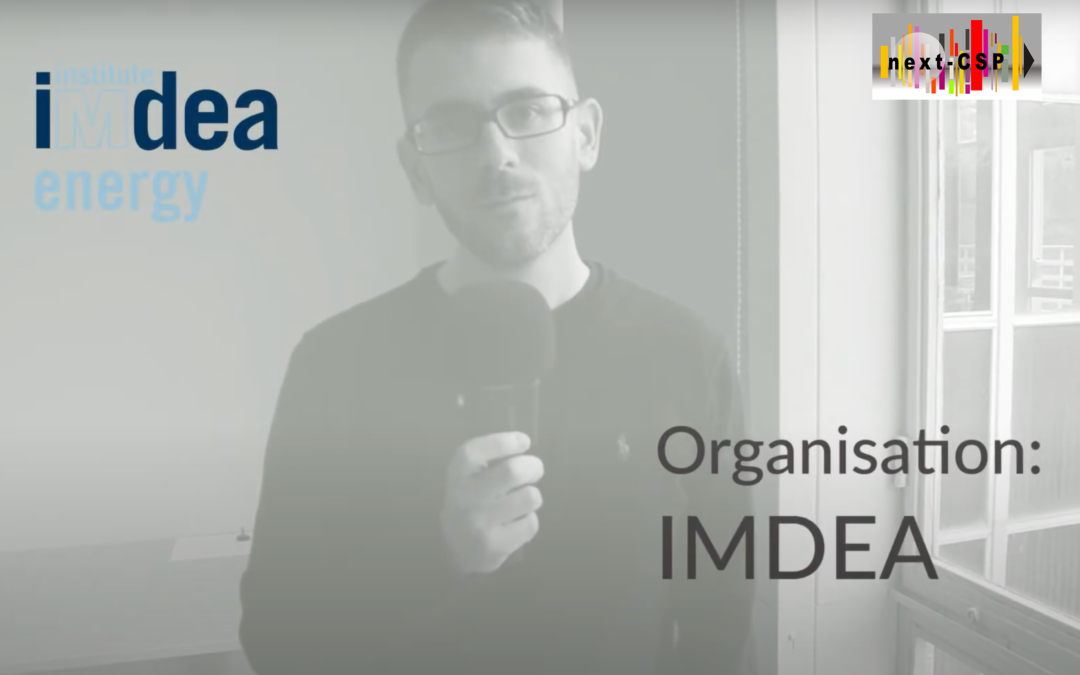Discover the Next-CSP partners in our interview series in video. Miguel Reyes, postdoctoral researcher at IMDEA Energy Institute (Spain) has answered 6 questions about his implication in the project.
You can also find all the partners interviews in the Communication materials section of the Next-CSP website.
Can you tell us a bit about yourself?
My name is Miguel Reyes, I’m a postdoctoral researcher at the IMDEA Energy Institute and an associate lecturer at the University Rey Juan Carlos. My background is energy modelling, mainly thermal power plants and in particular characterisation of turbines.
What’s your role in Next-CSP?
Our role in the Next-CSP project is related to the optimisation of power cycles to be coupled to Next-CSP’s particle receiver concept.
Why did you decide to take part in the project?
I decided to take part in this project because I believe that concentrating solar power will be key for the near future with a high penetration of renewable energy sources. Because one of the main benefits of concentrating solar power is the fact that you can control the electricity dispatch based on the energy storage. It’s a great opportunity to prove that using particles as a storage medium is a clever idea because we can go to very high temperatures. This is something you cannot achieve with coal-fired commercial plants. And instead of that, the high temperature will allow us to move into very high efficiency power cycles.
What are the most challenging aspects of your role?
The most challenging part is that we’re envisioning what concentrating solar power plants will look like in the future. We don’t have that many components yet for this technology, for very high temperatures and using particles. So it’s going to be very challenging. And, related to my field, using, for example, combined cycles for the external heat addition that would happen in concentrating solar power is something very new. There isn’t that much expertise outdoors so we’re investigating it right now. We’re lucky to be part of a big consortium with many groups and companies who are leader in this technology. Working together and discussing all these technical questions is something that will give a very important output.
What success has been achieved since the beginning of the project?
Up to this moment, we have already optimised and designed what should be the working conditions of a common cycle which will operate at the temperature of the Next-CSP receiver. That’s 800 degrees, not that high for a common cycle but we came to a peculiar and very wise solution that allows us to achieve 6 more points of efficiency than current commercial power plants for concentrating solar power.
What should be the next steps after the end of the project?
I think we’re already one step further because we’re already proving this technology at a pre-commercial level that is 4 megawatt thermal. That’s an interesting size for pre-commercial technology. But obviously, the next stage will be to demonstrate this concept in a commercial size, let’s say, 10 times bigger: 50 or 60 megawatts. That’s something for which we’ll need some industrial partners. I think industries are really interested in this because one of the challenges we need to overcome is to contribute to the cost reduction of the technology. And one way to go is to increase the efficiency of the power cycle which, according to thermodynamics, is something related to the temperature. Now that we can go up to 800 degrees easily with particles, we can move to very high efficiency combined cycles on that kind of power cycles. Obviously, those companies will be very interested. They should keep an eye on the output of the project. We still have about a year to go, so let’s see.

